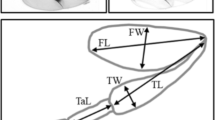Summary
Positive intraspecific allometry, the tendency for large individuals to have relatively larger morphological traits, is thought to be more likely for secondary sexual traits than naturally selected traits. This is because secondary sexual traits are often used to signal individual quality and positive allometry should arise where the costs and/or benefits of signalling are size dependent. Here we examine the allometric relationships between forceps length, a sexually selected trait and elytra length, a naturally selected trait, in 42 species of earwig. Both forceps and elytra showed positive allometry. However, the degree of allometry was greater for forceps as predicted. If allometry arises due to sexual selection we would predict a greater degree of allometry in species with more exaggerated secondary sexual traits. Across species, the degree of forcep allometry did increase with forcep exaggeration. The relevance of positive allometry to reliable signalling is discussed.
Similar content being viewed by others
References
Alatalo, R.V., Hoglund, J. and Lundberg, A. (1988) Patterns of variation in tail ornament size in birds.Biol. J. Linn. Soc. 34 363–74.
Andersson, M. (1986) Evolution of condition dependent sex ornaments and mating preferences: sexual selection based on viability differences.Evolution 40 804–16.
Arnqvist, G. (1994) The cost of male secondary sexual traits: developmental constraints during ontogeny in a sexually dimorphic water strider.Am. Nat. 144 119–32.
Briceno, R.D. and Eberhard, W.G. (1995) The functional morphology of male cerci and associated characters in 13 species of tropical earwigs (Dermaptera Forficulidae, Labiidae, Carcinophoridae, Pygidicranidae).Smithsonian Contribut. Zool. 555.
Brown, L. and Bartalon, J. (1986) Behavioral correlates of male morphology in a horned beetle.Am. Nat. 127 565–70.
Clutton-Brock, T.H., Albon, S.D. and Harvey, P.H. (1980) Antlers, body size and breeding group size in Cervidae.Nature 285 565–7.
Davies, N.B. and Halliday, T.R. (1979) Competitive mate searching in common toads,Bufo bufo.Anim. Behav. 27 1253–67.
Giles, E.T. (1963) The comparative external morphology and affinities of the Dermaptera.Trans. R. Ent. Soc. Lond. 115 95–163.
Gould, S.J. (1973a) The origin and function of ‘bizarre’ structures: antler size and skull size in the ‘Irish elk’,Megaloceros giganteus.Evolution 28 191–220.
Gould, S.J. (1973b) Positive allometry of antlers in the ‘Irish Elk’,Megaloceros giganteus.Nature 244 375–6.
Grafen, A. (1989) The phylogenetic regression.Phil. Trans. Roy. Soc. Lond. 326 119–56.
Green, A.J. (1992) Positive allometry is likely with mate choice, competitive display and other functions.Anim. Behav. 43 170–2.
Harvey, P.H. and Pagel, M.D. (1991)The Comparative Method in Evolutionary Biology. Oxford University Press, Oxford.
Huxley, J.S. (1931) The relative size of antlers in deer.Proc. Zool. Soc. Lond. 1931, 819–64.
Knabke, J.J. and Grigarick, A.A. (1971) Biology of the African earwig,Euborellia cincticollis (Gerstaecker) in California and comparative notes onEuborellia annulipes (Lucas).Hilgardia 41 157–94.
Moore, A.J. and Wilson, P. (1993) The evolution of sexually dimorphic earwig forceps: social interactions among adults of the toothed earwig,Vostox apicedentatus.Behav. Ecol. 4 40–8.
Otte, D. and Stayman, K. (1979) Beetle horns: some patterns in functional morphology. InSexual selection and reproductive competition in insects (M.S. Blum and N.A. Blum, eds.), pp. 259–92. Academic Press, London.
Parker, G.A. (1974) Assessment strategy and the evolution of fighting behaviour.J. Theor. Biol. 47 223–43.
Petrie, M. (1984) Territory size in the moorhen (Gallinula chloropus): an outcome of RHP asymmetry between neighbours.Anim. Behav. 32 861–70.
Petrie, M. (1988) Intraspecific variation in structures that display competitive ability: large animals invest relatively more.Anim. Behav. 36 1174–80.
Petrie, M. (1992) Are all secondary sexual display structures positively allometric and, if so, why?Anim. Behav. 43 173–5.
Popham, E.J. (1965) The functional morphology of the reproductive organs of the Common earwig (Forficula auricularia) and other Dermaptera with reference to the natural classification of the order.J. Zool. 146 1–43.
Purvis, A. and Rambaut, A. (in press) Comparative analysis by independent contrasts (C.A.I.C.): an Apple Macintosh application for analysing comparative data.Computer Appl. Biosci.
Radesäter, T. and Halldórsdóttir, H. (1993a) Fluctuating asymmetry and forceps size in earwigs,Forficula auricularia.Anim. Behav. 45 626–8.
Radesäter, T. and Halldórsdóttir, H. (1993b) Two male types of the common earwig: male—male competition and mating success.Ethology 95 89–96.
Reiss, M.J. (1989)The Allometry of Growth and Reproduction. Cambridge University Press, Cambridge.
Sakii, S. (1982) A new proposed classification of the Dermaptera with special reference to the check list of the Dermaptera of the world.Bull. Daito Bunka Univ. 20 1–108.
Sigurjónsdóttir, H. and Parker, G.A. (1981) Dung fly struggles: evidence for assessment strategy.Behav. Ecol. Sociobiol. 8 219–30.
Simmons, L.W. (1986) Intermale competition and mating success in the field cricket,Gryllus bimaculatus (De Geer).Anim. Behav. 34 567–79.
Sokal, R.R. and Rohlf, F.J. (1981)Biometry. W.H. Freeman, New York.
Zahavi, A. (1975) Mate selection-selection for a handicap.J. Theor. Biol. 53 205–14.
Author information
Authors and Affiliations
Rights and permissions
About this article
Cite this article
Simmons, L.W., Tomkins, J.L. Sexual selection and the allometry of earwig forceps. Evol Ecol 10, 97–104 (1996). https://doi.org/10.1007/BF01239350
Issue Date:
DOI: https://doi.org/10.1007/BF01239350




